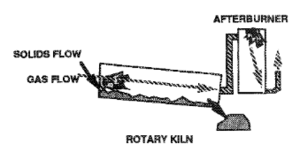Rotary Kiln
Rotary are very robust and are often used in solid/liquid waste incineration due to its versatility to treating a wide range of feedstocks from slurries (wet process) through to dry materials (dry process) and hazardous waste at high temperatures. The kiln is a continuous counter current reactor which consists of a long tube that is positioned at an angle near horizontal and is rotated. The angle and rotation allow feedstock to work its way down the tube and dictate their retention time in the kiln. Gas is passed through the tube counter current to the solid reactant[1].
The Process

A typical rotary kiln incineration unit consists of two elements: the rotary kiln and the afterburner/secondary combustion chamber. The feedstock enters the vessel positioned longitudinally approximately 5-30° of the horizontal position and located on rollers which ensures a continuous motion of catalyst. The kiln contains a burner which is fired axially either in the same direction as the solids (co-flow) or the opposite direction (counter flow) to achieve good waste burnout. The residence time of the waste in the kiln is between 30 to 90 minutes. The afterburner/secondary combustion chamber maintains high temperature to destroy the more stable hazardous flue gases (especially for incinerations of hazardous wastes) and the ash/slag is released[2].
